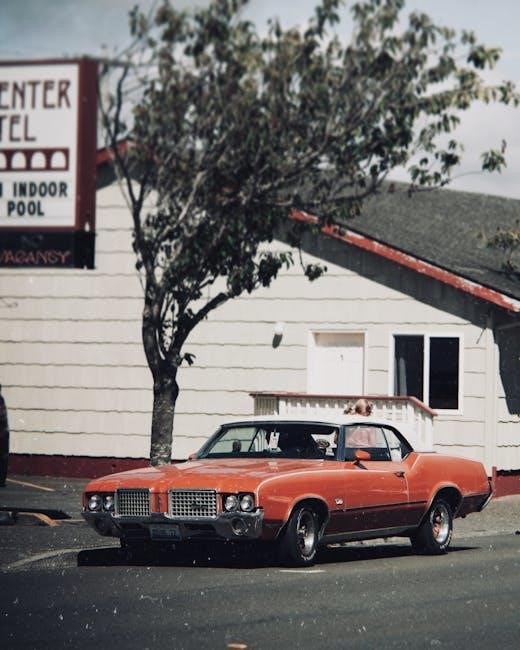
A Cell on Wheels (COW) is a mobile cell site providing temporary network coverage in high-demand areas or where permanent infrastructure is lacking. It ensures seamless connectivity during emergencies, events, or network upgrades, offering rapid deployment and reliable service.
1;1 Definition and Purpose
A Cell on Wheels (COW) is a mobile cell site mounted on a trailer or vehicle, designed to provide temporary cellular network coverage and capacity. It is deployed in areas with high demand, emergencies, or insufficient permanent infrastructure. COWs ensure seamless connectivity during events, natural disasters, or network upgrades, offering rapid deployment and reliable service. Their primary purpose is to address coverage gaps and capacity needs, making them essential for modern telecommunications.
1.2 Brief History and Evolution
Cell on Wheels (COWs) originated in the 1990s as a solution for temporary cellular coverage. Initially developed by U.S. wireless carriers, they were designed for rapid deployment during emergencies or events. Over time, COWs evolved to incorporate advanced technologies like 4G LTE and 5G, enabling higher capacity and faster connectivity. Modern COWs feature modular designs, improved power systems, and AI-driven optimizations, making them indispensable for addressing coverage gaps in dynamic environments. Their evolution reflects the growing demand for reliable mobile telecommunications.
1.3 Importance in Modern Telecommunications
Cell on Wheels (COWs) play a vital role in modern telecommunications by ensuring seamless connectivity in diverse scenarios. They are essential for emergency communication during disasters, providing temporary coverage when infrastructure is damaged. COWs also support rural areas with limited network access and enable high-capacity connectivity at large events. Their ability to quickly deploy and adapt makes them critical for maintaining service continuity, preventing network congestion, and ensuring reliable communication in dynamic environments. This versatility underscores their importance in today’s connected world.

Applications of COWs
COWs provide emergency communication, temporary event coverage, and connectivity in rural areas, ensuring reliable service during disasters, festivals, and large gatherings like sports events.
2.1 Emergency Communication
Cell on Wheels (COWs) are critical in emergency situations, providing immediate communication networks during natural disasters, terrorist attacks, or infrastructure failures. They ensure connectivity for first responders, enabling coordination and lifesaving operations. COWs can be rapidly deployed to restore service in areas where traditional networks are damaged or destroyed, ensuring public safety and minimizing communication gaps during crises.
2.2 Temporary Event Coverage
Cell on Wheels (COWs) are widely used to provide temporary communication coverage for large events like festivals, sports games, and concerts. They enhance network capacity to handle high data traffic from attendees. COWs ensure seamless connectivity, enabling smooth communication and data sharing. Their portability allows quick deployment and removal, making them ideal for short-term events. This solution is cost-effective and avoids the need for permanent infrastructure, ensuring reliable service during peak demand periods.
2.3 Rural and Underserved Areas
Cell on Wheels (COWs) are instrumental in providing cellular coverage to rural and underserved areas where permanent infrastructure is lacking. These mobile units bridge the digital divide by delivering reliable connectivity to sparse populations. COWs enhance access to essential services like emergency communications, education, and healthcare. Their deployment ensures equitable opportunities for remote communities, fostering economic growth and social inclusion. This solution is vital for regions with limited resources, ensuring no one is left disconnected in the digital age.
2.4 Disaster Recovery and Relief
Cell on Wheels (COWs) play a critical role in disaster recovery and relief efforts by rapidly restoring communication networks in affected areas. After natural disasters like hurricanes, earthquakes, or floods, COWs are deployed to ensure emergency services and rescue teams can coordinate effectively. Their mobility and quick setup enable seamless connectivity, allowing affected communities to access vital information and stay in touch with loved ones during crises. This makes COWs indispensable in maintaining communication networks when traditional infrastructure is damaged or destroyed.
2.5 Special Events and Large Gatherings
Cell on Wheels (COWs) are widely used to provide reliable connectivity during special events and large gatherings, such as concerts, sports events, or festivals. These portable solutions ensure high-capacity network coverage, reducing congestion and enhancing user experience. COWs enable seamless communication for both attendees and organizers, supporting activities like live streaming, social media sharing, and emergency services. Their deployment ensures uninterrupted connectivity, making them essential for managing large-scale events effectively and efficiently.

Technical Specifications
Cell on Wheels (COWs) are equipped with advanced communication equipment, including antennas, transceivers, and power systems, ensuring reliable connectivity and customizable solutions for various deployment scenarios.
3.1 Design and Construction
Cell on Wheels (COWs) are designed for durability and portability, typically constructed with lightweight yet robust materials like steel and fiber-reinforced polymers. They feature retractable or telescoping towers for easy transportation and deployment. The units are equipped with antennas, transceivers, and power systems, ensuring reliable operation in diverse environments. The design emphasizes scalability, allowing for customization to meet specific deployment needs, while maintaining energy efficiency and safety standards.
3.2 Tower Height and Coverage Radius
Cell on Wheels (COWs) typically feature towers with adjustable heights, ranging from 20 to 100 feet, to optimize signal strength and coverage. The coverage radius varies based on terrain, frequency, and power output, often extending up to 5 miles in rural areas and 1 mile in urban environments. Higher towers reduce signal obstruction and improve connectivity, while lower settings enhance portability. This adaptability ensures efficient deployment across diverse scenarios, balancing performance and mobility effectively.
3.3 Power and Energy Requirements
Cell on Wheels (COWs) require significant power to operate their communication equipment, typically relying on generators or external power sources. Fuel efficiency is crucial, as continuous operation during emergencies or remote deployments is essential. Backup systems, such as batteries, ensure uninterrupted service during power outages. Energy consumption varies based on the equipment load and coverage demands, making it vital to balance performance with energy efficiency to maintain reliability and operational readiness in diverse scenarios.
3.4 Communication Equipment and Features
Cell on Wheels (COWs) are equipped with advanced communication equipment, including antennas, transceivers, and baseband units, enabling high-speed data transmission and voice services. They often support 5G, LTE, and legacy technologies, ensuring compatibility and seamless connectivity. Features like MIMO (Multiple Input Multiple Output) enhance coverage and capacity. Additionally, COWs may include remote monitoring systems, ensuring optimal performance and quick troubleshooting. These units are designed to integrate with existing networks, offering scalable solutions for diverse communication needs.
Deployment and Installation
Deployment involves transporting COWs to sites, setting up antennas, and connecting power. Activation ensures network integration and signal optimization for reliable communication services.
4.1 Site Selection and Preparation
Site selection for COWs involves identifying a strategic location that maximizes coverage while ensuring accessibility. The area must be level and stable to support the unit’s weight and stability. Proximity to power sources and minimal obstructions are critical for optimal signal strength. Preparation includes clearing terrain, ensuring drainage, and securing the site to prevent unauthorized access or damage.
4.2 Transportation and Mobility
COWs are designed for easy transportation and rapid deployment. They are typically mounted on heavy-duty trailers or trucks, ensuring mobility across various terrains. Their compact size and roadworthiness allow them to navigate through narrow roads and remote areas. Specialized vehicles may be required for long-distance hauling, while helicopters or cranes are used for airlifting in inaccessible locations. Operators must ensure secure fastening during transit to prevent damage.
4.3 Setup and Activation Process

Setting up a COW involves positioning the unit at the designated site, ensuring stability and leveling the platform. The antenna and other equipment are then deployed, and power sources like generators are connected. Activation includes configuring communication systems, establishing network connections, and testing signal strength. Once operational, the COW is integrated into the existing network to provide seamless coverage. The entire process is designed for rapid execution to meet urgent connectivity needs.

Benefits and Advantages
COWs offer rapid deployment, flexibility, and cost-effectiveness, ensuring reliable communication in diverse scenarios. They enhance network coverage and scalability, making them indispensable for temporary or emergency needs.

5.1 Rapid Deployment

COWs enable rapid deployment of cellular networks, crucial for emergencies or events. Their mobile design allows quick transport and setup, ensuring minimal downtime. Pre-configured systems and self-contained power solutions streamline activation, making them ideal for temporary or disaster scenarios. This swift deployment capability ensures continuous communication, supporting critical operations and public safety effectively.
5.2 Flexibility and Scalability
COWs offer exceptional flexibility and scalability, adapting to diverse communication needs. Their modular design allows for easy customization, enabling them to support various network configurations. Whether for small rural areas or large events, COWs can scale up or down to meet demand. They also integrate seamlessly with existing infrastructure, ensuring compatibility and efficiency. This adaptability makes them a versatile solution for evolving telecommunications requirements, addressing both immediate and long-term needs effectively.
5.3 Cost-Effectiveness
COWs provide a cost-effective solution for temporary or remote communication needs. By eliminating the need for permanent infrastructure, they reduce construction and maintenance costs. Their ability to be reused across multiple locations and events maximizes investment. Energy-efficient designs and remote management capabilities further lower operational expenses. This makes COWs an economical choice for addressing coverage gaps without the financial burden of traditional network expansion.
5.4 Enhanced Network Reliability
COWs significantly improve network reliability by providing stable and consistent connectivity. Equipped with advanced equipment, they ensure uninterrupted service during emergencies or high-traffic events. Features like backup power systems and redundancy ensure continuous operation. Their ability to adapt to challenging conditions makes them ideal for maintaining reliable communication in remote or disaster-stricken areas, ensuring seamless connectivity when it’s needed most.

Challenges and Limitations
COWs face challenges like deployment logistics, power constraints, and environmental factors. These limitations can impact their effectiveness in certain scenarios, requiring careful planning and resources to overcome.
6.1 Environmental Factors
COWs are often deployed in challenging environments, facing issues like extreme weather, high winds, and humidity. Harsh conditions can impact equipment durability and signal stability. Weather resistance is crucial for maintaining reliable connectivity, especially in disaster scenarios. Environmental factors also include temperature fluctuations, which can affect battery life and system performance. Dust and moisture ingress are additional concerns, requiring specialized protective measures to ensure optimal functionality. These factors highlight the need for robust design and maintenance to withstand varying environmental conditions effectively.
6.2 Power Supply Constraints
COWs often face power supply challenges, particularly in remote or disaster-stricken areas with limited electricity access. They rely on alternative power sources like diesel generators or batteries, which can be costly and require frequent refueling. Battery life is limited, and recharging may be difficult without a stable power grid. Solar power is an emerging solution but depends on weather conditions. Balancing energy demands with power availability remains a critical challenge for sustained COW operations in the field.
6.3 Deployment Logistics
Deployment logistics for COWs involve transportation, site preparation, and setup, requiring precise planning. Transportation can be challenging due to the size and weight of the units, often needing specialized vehicles. Site preparation includes ensuring stable ground and proper alignment. Setup involves assembling antennas, connecting power sources, and configuring systems. Rapid deployment is critical, especially in emergencies, making efficient logistics essential for maintaining communication services in demanding scenarios.
Real-World Deployments
COWs are widely deployed in emergency response, large public events, and rural areas, ensuring seamless communication during critical situations and network outages, enhancing connectivity and supporting operations effectively.
7.1 Case Studies and Success Stories
COWs have proven invaluable in real-world scenarios, such as disaster recovery and large-scale events. For instance, during hurricanes, COWs restored communication networks quickly, ensuring emergency services remained operational. Similarly, at major festivals, they provided reliable coverage for thousands of attendees. In rural areas, COWs bridged connectivity gaps, enabling remote communities to access essential services. These deployments highlight their versatility, scalability, and critical role in maintaining communication during crises and high-demand situations, showcasing their effectiveness and reliability.
7.2 Lessons Learned and Best Practices
Deployments of COWs have revealed key lessons, such as the importance of thorough site preparation and robust power backup solutions. Rapid deployment teams should prioritize clear communication with local authorities and ensure seamless integration with existing networks. Regular maintenance and upgrades are crucial to prevent downtime. Additionally, leveraging real-time monitoring tools enhances performance tracking. These best practices ensure efficient, reliable, and scalable deployments, maximizing the effectiveness of COWs in diverse scenarios, from emergencies to large events.

Integration with Other Technologies
COWs enhance capabilities by integrating with UAVs, 5G networks, and private enterprise solutions, ensuring seamless communication and expanded coverage in dynamic environments.
8.1 UAVs (Unmanned Aerial Vehicles)
COWs can integrate with UAVs to create hybrid communication systems, extending coverage in remote or disaster-stricken areas. UAVs act as aerial relays, enhancing signal strength and reach. This collaboration allows for real-time data synchronization, ensuring seamless connectivity during emergencies. The combination of ground-based COWs and airborne UAVs provides robust, adaptable solutions for temporary or hard-to-reach locations, making them ideal for search and rescue missions or large-scale events. This synergy maximizes communication reliability and flexibility.
8.2 5G and Next-Generation Networks
COWs are increasingly being integrated with 5G and next-generation networks to deliver high-speed, low-latency connectivity. This integration enhances the capacity of COWs to support massive machine-type communications and ultra-reliable low-latency communication (URLLC) applications. By leveraging 5G’s advanced features, COWs can dynamically allocate resources, ensuring optimal performance in temporary or emergency scenarios. This synergy enables faster deployment of cutting-edge wireless technologies, making COWs indispensable for modern network infrastructures and future-proof communication solutions.
8.3 Private Networks and Enterprise Solutions
COWs are being adopted by enterprises to establish private networks, ensuring secure and dedicated connectivity. These solutions are ideal for industries like manufacturing, education, and hospitality, where customized communication needs arise. Enterprises leverage COWs to create temporary or permanent private networks, enabling reliable and high-speed connectivity for specific events or remote locations. This approach enhances operational efficiency and provides a scalable solution for organizations requiring tailored network services without dependence on public infrastructure.
Future Trends and Innovations
Future trends include integrating COWs with 5G networks, AI-driven deployment, and green energy solutions, enhancing mobility, efficiency, and sustainability in telecommunications infrastructure.
9.1 Advancements in Mobile Infrastructure

Advancements in mobile infrastructure for COWs focus on integrating next-generation technologies like 5G and edge computing. These enhancements enable faster data processing, lower latency, and improved connectivity. Modular, compact designs are being developed to support scalability and customization. Additionally, energy-efficient solutions and advanced networking capabilities, such as beamforming and MIMO, are being implemented to optimize performance and reliability in diverse deployment scenarios.
9.2 Autonomous and AI-Driven COWs
Autonomous and AI-driven COWs represent the future of mobile communication, leveraging artificial intelligence to optimize network performance and deployment. AI algorithms enable real-time data analysis, predictive maintenance, and dynamic resource allocation. These systems can autonomously adjust coverage areas, manage traffic, and troubleshoot issues, reducing the need for manual intervention. Autonomous COWs also integrate with emerging technologies like machine learning to enhance decision-making and improve network reliability in complex environments.
9.3 Green Energy Solutions for COWs
Green energy solutions are transforming COWs by reducing their environmental impact. Solar panels, wind turbines, and energy storage systems are being integrated to power COWs, minimizing reliance on fossil fuels. Hybrid power systems combine renewable energy with diesel generators for backup, ensuring continuous operation. These eco-friendly solutions lower carbon emissions, reduce operational costs, and enhance sustainability, making COWs more viable for long-term deployments in environmentally sensitive areas while maintaining high performance and reliability.
Cell on Wheels (COWs) are versatile, scalable solutions enhancing telecommunication capabilities. Their rapid deployment, reliability, and adaptability make them indispensable for modern connectivity needs, driving innovation and accessibility.
10.1 Summary of Key Points
Cell on Wheels (COWs) are mobile telecommunication solutions providing temporary or supplemental connectivity. They are used in emergencies, events, and underserved areas, offering rapid deployment and flexibility. COWs enhance network reliability and scalability, addressing communication needs during disasters or large gatherings. Their portable design and robust features make them indispensable for modern telecom challenges, ensuring seamless connectivity when traditional infrastructure is insufficient or damaged.
10.2 Impact on Telecommunications
Cell on Wheels (COWs) have revolutionized telecommunications by providing reliable, portable connectivity solutions. They ensure uninterrupted service during disasters, events, and in remote areas, enhancing network resilience. COWs support rapid deployment of 5G and next-gen technologies, enabling faster adoption. Their versatility bridges coverage gaps, strengthens infrastructure, and maintains communication continuity, making them indispensable for modern telecom needs and driving innovation in the industry.